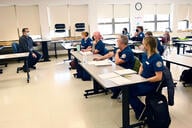You have /5 articles left.
Sign up for a free account or log in.
As we approach the second decade of the century, it is fair to ask what young medical doctors should know and where and when they should learn it. But amid calls for revisions to the undergraduate premedical curriculum, undergraduate colleges must guard against being co-opted as “farm clubs” for “big league” schools of medicine.
In the American system of higher education, to paraphrase the opening of a popular television series, the task of educating and training tomorrow’s doctors is shared by two separate yet equally important institutions: baccalaureate colleges of arts and sciences and professional schools of medicine. And, as the ubiquitous use of the term “pre-med” implies, undergraduate educators have long accepted their responsibility to equip students who aspire to become physicians with the knowledge and skills essential for admission to medical school. It follows from this premise that changes in the scope and focus of medical school curricula will raise legitimate questions about the courses most appropriate for premed students.
This argument furnishes the starting point for a recent contribution by Jules L. Dienstag to the New England Journal of Medicine (“Relevance and Rigor in Premedical Education”). In his essay, Dienstag notes the demands placed on medical school faculties by an ever expanding range of “new scientific material” and deplores the “widely varied levels of science preparation” among first-year medical students. As a remedy, he proposes a radical reshaping of the pre-medical science curriculum and a corresponding revision of both the Medical College Admissions Test (or MCAT) and the criteria used by medical school admissions committees. By “refocusing” and “increasing [the] relevance” of the science courses pre-med students take, Dienstag argues, undergraduate institutions could better prepare graduates for professional school while simultaneously opening up additional space in the curriculum for “an expansive liberal arts education encompassing literature, languages, the arts, humanities, and social sciences.”
Dienstag’s prescription deserves serious consideration by faculty and administrators at baccalaureate and professional institutions alike. He offers valuable suggestions on a range of issues. But Dienstag naturally approaches this topic from his own perspective -- that of the dean for medical education at Harvard Medical School. In advocating for changes that would address the challenges facing his own colleagues, he ignores (or at least passes too quickly over) complications and contradictions that those changes would create at undergraduate colleges.
Each entering class at any undergraduate institution contains many more students who express their firm intention to become medical doctors than will ever apply to a medical school, let alone gain admission. Some will learn in Chemistry 101 that their intellectual gifts are not those of a scientist. Others will be seduced by the excitement of laboratory research and pursue Ph.D. rather than M.D. degrees. Still others will surprise themselves (not to mention their parents) by discovering a passion for literature or archaeology, economics or music that overwhelms their earlier conviction about their destined career paths.
Such defections are scarcely surprising, given the limited knowledge and experience that high school students rely on as the basis for forming their views about possible life goals. But it is also important to recognize that many undergraduate institutions – liberal arts colleges in particular – actively encourage their students to remain intellectually curious and open to the full range of disciplines that they sponsor. “Pursue your passion,” we advise incoming first-year students at the College of the Holy Cross. “Find what excites and fulfills you and see where it may lead.” Tracking pre-med students into what Dienstag describes as a science curriculum with “a tighter focus on science that ‘matters’ to medicine” runs counter to this liberal arts ethos. While it might better prepare the minority of those students who will one day matriculate at a school of medicine, it could handicap those whose scientific interests point them toward industry or teaching and research. It could also restrict the breadth of the scientific education that non-science majors would take with them if later decisions led them towards majors in the humanities, arts or social sciences. And even for the small number of students who would in fact emerge from such a streamlined curriculum and enter medical school, one has to question the wisdom of targeting “biologically relevant” material at the expense of courses in topics as critical to the future of our planet as ecology and population genetics.
Another way of explaining the unease that some faculty members at liberal arts colleges may feel over Dienstag’s proposal is that it implies that the study of biology, chemistry, physics and statistics is undertaken as a means -- and to one very particular end. The attitude we seek to foster in our students at liberal arts institutions, by contrast, is that one studies a discipline for what it reveals about the universe we inhabit and about what the mission statement at the College of the Holy Cross calls “basic human questions.” The knowledge and skills that one acquires in the process will be equally useful in one’s career and in one’s life outside the workplace and certainly do not limit who one may become, either professionally or personally.
There is no question that the combined eight-year premedical and medical school curriculum that has served us well for decades is coming under increasing pressure. With each year that passes, society expects more of its physicians; as Dienstag notes, we now demand that they be trained not only in medical science but also in “ethics, … listening skills, and skills relevant to health policy and economics.” Unless we are to extend the already long training period by another year, changes in what we teach and how we teach it are inevitable.
Dienstag urges those of us who teach undergraduates not to “shy away from the challenge” posed by this shifting environment. I suggest that the challenge we confront can not be addressed effectively without all parties being open to possible changes in the way they contribute to the process. More importantly, our colleagues in the professional schools must understand that the term “pre-med” designates a provisional career aspiration far more often than it does a firm commitment. Undergraduate students are by definition still learning about their world and seeking out their place in it, so our institutions serve their needs when we balance the importance of effective pre-professional preparation with the equally compelling need for curricular flexibility and disciplinary breadth.




